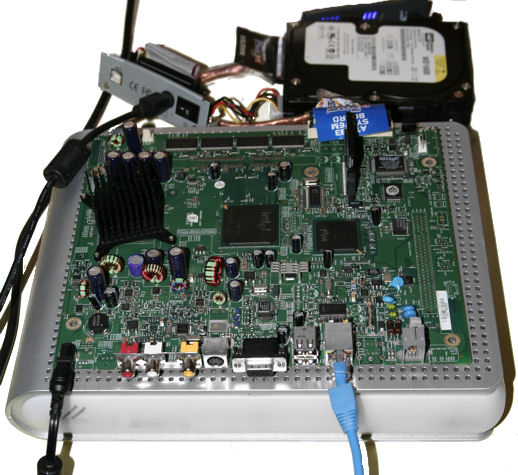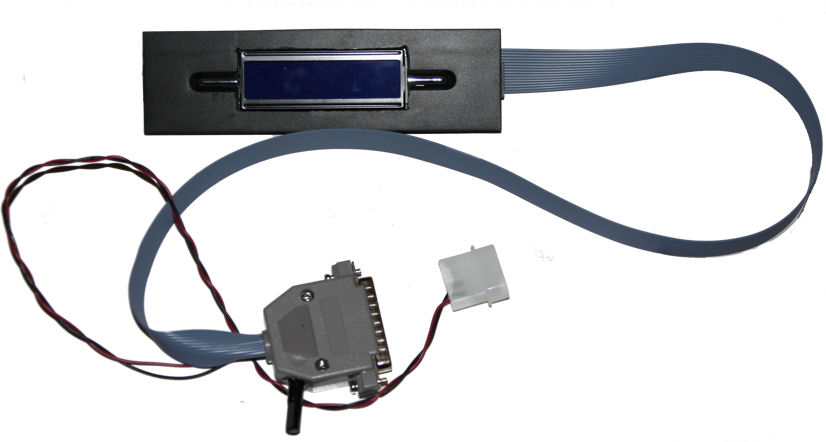MSNTV2 Hardware & Architecture
Here’s what phpSysInfo has to say:
Processors 1 Model Mobile Intel(R) Celeron(TM) CPU 733MHz CPU Speed 731.08 Mhz Cache Size 256.00 KB System Bogomips 1445.88 PCI Devices - Ethernet controller: Intel Corporation 82801DB PRO/100 VE - Host bridge: Intel Corporation 82830 830 Chipset Host Bridge - IDE interface: Intel Corporation 82801DB - ISA bridge: Intel Corporation 82801DB/DBL - Modem: Intel Corporation 82801DB/DBL/DBM - Multimedia audio controller: Intel Corporation 82801DB/DBL/DBM - PCI bridge: Intel Corporation 82801 PCI Bridge - SMBus: Intel Corporation 82801DB/DBL/DBM - (3x) USB Controller: Intel Corporation 82801DB/DBL/DBM - USB Controller: Intel Corporation 82801DB/DBM - VGA compatible controller: Intel Corporation 82830 CGC [Chipset Graphics Controller] IDE Devices - hda: SanDisk SDCFB-64 (Capacity: 61.25 MB) - hdc: WDC WD1600JB-00GVC0 (Capacity: 149.05 GB) SCSI Devices none USB Devices none
Here’s the dump of /proc/cpuinfo:
$ cat cpuinfo processor : 0 vendor_id : GenuineIntel cpu family : 6 model : 11 model name : Mobile Intel(R) Celeron(TM) CPU 733MHz stepping : 4 cpu MHz : 731.087 cache size : 256 KB fdiv_bug : no hlt_bug : no f00f_bug : no coma_bug : no fpu : yes fpu_exception : yes cpuid level : 2 wp : yes flags : fpu vme de pse tsc msr pae mce cx8 mtrr pge mca cmov pat pse36 mmx fxsr sse bogomips : 1445.88
An explaination of what the flags are is available here: Intel® 64 and IA-32 Architectures Software Developer’s Manuals in Volume 2: Instruction Set Reference, specifically pages
3-172
to
3-176
of Volume 2A: Instruction Set Reference
Here is the output of lspci on an MSNTV2:
$ lspci -tvv
-[00]-+-00.0 Intel Corporation 82830 830 Chipset Host Bridge
+-02.0 Intel Corporation 82830 CGC [Chipset Graphics Controller]
+-1d.0 Intel Corporation 82801DB/DBL/DBM (ICH4/ICH4-L/ICH4-M) USB UHCI Controller #1
+-1d.1 Intel Corporation 82801DB/DBL/DBM (ICH4/ICH4-L/ICH4-M) USB UHCI Controller #2
+-1d.2 Intel Corporation 82801DB/DBL/DBM (ICH4/ICH4-L/ICH4-M) USB UHCI Controller #3
+-1d.7 Intel Corporation 82801DB/DBM (ICH4/ICH4-M) USB2 EHCI Controller
+-1e.0-[01]----08.0 Intel Corporation 82801DB PRO/100 VE (CNR) Ethernet Controller
+-1f.0 Intel Corporation 82801DB/DBL (ICH4/ICH4-L) LPC Interface Bridge
+-1f.1 Intel Corporation 82801DB (ICH4) IDE Controller
+-1f.3 Intel Corporation 82801DB/DBL/DBM (ICH4/ICH4-L/ICH4-M) SMBus Controller
+-1f.5 Intel Corporation 82801DB/DBL/DBM (ICH4/ICH4-L/ICH4-M) AC'97 Audio Controller
\-1f.6 Intel Corporation 82801DB/DBL/DBM (ICH4/ICH4-L/ICH4-M) AC'97 Modem Controller
Here’s the dump of /proc/ioports:
$ cat /proc/ioports 0000-001f : dma1 0020-0021 : pic1 0040-0043 : timer0 0050-0053 : timer1 0060-006f : keyboard 0070-0077 : rtc 0080-008f : dma page reg 00a0-00a1 : pic2 00c0-00df : dma2 00f0-00ff : fpu 0170-0177 : ide1 01f0-01f7 : ide0 02f8-02ff : serial 0376-0376 : ide1 03c0-03df : ega 03f6-03f6 : ide0 03f8-03ff : serial 0500-053f : 0000:00:1f.0 0cf8-0cff : PCI conf1 1000-107f : 0000:00:1f.0 8000-801f : 0000:00:1d.0 8020-803f : 0000:00:1d.1 8040-805f : 0000:00:1d.2 9000-903f : 0000:01:08.0 9000-903f : e100 a020-a02f : 0000:00:1f.1 a040-a05f : 0000:00:1f.3 a100-a1ff : 0000:00:1f.5 a200-a23f : 0000:00:1f.5 a300-a3ff : 0000:00:1f.6 a400-a47f : 0000:00:1f.6
Here’s the dump of /proc/interrupts:
$ cat /proc/interrupts
CPU0
0: 32149675 XT-PIC timer
2: 0 XT-PIC cascade
4: 169 XT-PIC serial
5: 6825495 XT-PIC eth0
8: 2 XT-PIC rtc
14: 87 XT-PIC ide0
15: 14329233 XT-PIC ide1
NMI: 0
LOC: 0
ERR: 0
MIS: 0
Update:
Probing for `SMSC 47M15x/192 Super IO Fan Sensors' Success... found at address 0x0800
It looks like the fan controller is an SMSC 47M1, meaning you can control and monitor fan speed using programs such as lm-sensors. Here is the doc file for the SMSC 47M1.




